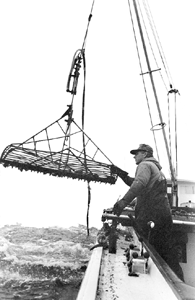 Chesapeake
Oysters ~
Chesapeake
Oysters ~  Chesapeake
Oysters ~
Chesapeake
Oysters ~ When the tongs are closed and divers’ suits packed away March 31, the last oyster harvest of the 20th century will be ready for counting. In Maryland, it’s going to be above 300,000 bushels. That’s a 70 percent increase from just two years ago and a massive 279 percent over the Maryland oyster’s worst year, 1994.
"This upward trend shows that oysters are surviving better as opposed to dying. With better survival, the population is increasing and the industry recovering some," says Chris Judy, director of the shellfish division of Maryland Department of Natural Resources.
But it’s a "slight recovery" -- a long way from the mountains
of oysters harvested a century ago -- "or even 15 years ago, with over
a million bushels harvested," notes Judy.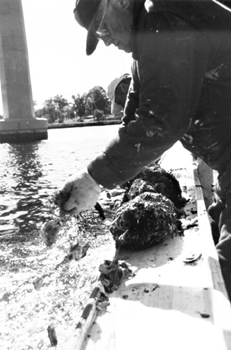
What those scant figures don’t tell is that "arsterin’" is as energetic as ever in Chesapeake Bay. It’s just taken a different turn. The single-mindedness that once went into harvesting oysters goes now to their planting. The wild oyster, Crassostrea Virginica, still survives in Chesapeake Bay -- with a lot of help.
Old oyster shells are gathered into mesh bags to which oyster seed is allowed to settle. Later, volunteers empty these bags, allowing the spat to settle and grow.
Thousands of modern oystermen and women are laboring to sustain oysters in Chesapeake Bay into the 21st century. Some are traditional oystermen, who use their skill and supplement their income by working with DNR dredging oyster shell from the bottoms, rebuilding oyster reefs, seeding and raking them.
In some of the Bay’s most productive areas -- the Little Choptank, the Eastern Bay and the Choptank River -- millions of bushels of shell have been planted. Those recreated habitats make homes for whole ecosystems of Bay life, and when oysters return, their beds are waiting.
Today’s oyster army is not content to wait for that someday. Every April, oystermen under hire by DNR dredge up some of the abundant seed in oyster-rich areas for replanting in debilitated areas. "In the Tangier Sound area, you can see a dozen boats dredging up shell and spat and moving it up to the northern part of the Bay, where disease is not so bad," said oysterman Kenny Keen, president of the Calvert Watermen’s Association and captain of Longshot.
Last year was an extraordinarily fecund year. One billion spat were planted in seed programs to restore depleted beds. "The end result is that two to three years down the road," says DNR’s Judy, "that seed may grow to harvest. They have a very good chance of surviving because we put them in successful areas. We hope to increase Chesapeake Bay’s oyster crop because of this good year."
Many arsterin’ in Chesapeake Bay are volunteers. Chesapeake Bay Foundation alone counts over 1,000 volunteers in its Baywide restoration programs. The foundation’s Citizen Oyster Corps are oyster gardeners who work either at preparing bags of oyster seed to be nurtured in floating nurseries and planted on Bay bottoms or who work at helping to organize workshops to bring still more people into the circle. From school children to senior citizens, many thousands of volunteers arster with one or another organization up and down the Bay.
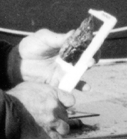 Behind these field workers, teams
of researchers and applied scientists supply the hard knowledge that’s
as fundamental to oyster survival as nicely made beds of old shell.
Behind these field workers, teams
of researchers and applied scientists supply the hard knowledge that’s
as fundamental to oyster survival as nicely made beds of old shell.
One of those specialists is Don Meritt of University of Maryland’s Center for Estuarine Science Horn Point Laboratory on the Choptank River. With a mission of providing disease-free oyster spat to seed the Bay, Meritt’s piece in the picture is discovering how to best get oysters to grow. He’s tried to get oysters to settle on just about every solid surface you can think of -- string, sticks, trays, concretized egg cartons -- before settling on nature’s choice: old oyster shells. This year his hatchery expects to produce "15 or 20 thousand" mesh bags of old shell -- with, by planting time, five or 10 vital young spat attached to each shell.
Mike Previti measures oysters grown off his
Patuxent River pier.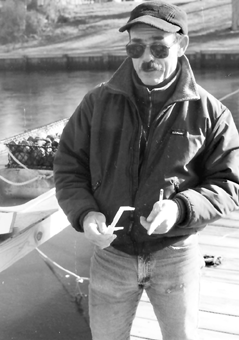
"You can do enough with a hatchery to make a difference," says Meritt.
That is if you’ve got good seed. Today, oysters are bred like corn: selected, crossed and studied over generations by scientists who devote their lives to developing a champion strain.
Research into disease-resistant Eastern oysters began in the ’50s, soon after the disease MSX appeared in Delaware Bay. Scientists at Rutgers University bred the survivors, developing a pedigreed line of oysters tolerant of MSX.
Forty years later, a second scourge invaded. Assaulted by dermo, many MSX resistant oysters died. The scientists had a second challenge: breeding a stock resistant to both dermo and MSX. With CROSBreed, a strain from the original Rutgers pedigree bred by Dr. Standish Allen at Virginia Marine Institute, they may have succeeded. Allen calls CROSBreed -- which is short for cooperative regional oyster selective breeding project -- "my favorite acronym in my career."
Here, in Allen’s words, is how it’s supposed to work: "We know MSX survivors’ kids will be more resistant. That’s genetic progress. Are survivors of dermo exposure more resistant? With only two generations’ exposure, we don’t know. It is our hope dermo will be an added disease in their resistance."
Results are mixed in the strain’s three testing grounds -- Delaware Bay, the Choptank River and the Virginia seaside. But in the Bay, the hybrid seems promising.
"It will get its broadest test this year on the bottom of the Bay," Chesapeake Bay Foundation senior scientist Bill Goldsborough told a contingent of the foundation’s Oyster Corps gathered recently to learn the state of 21st century oyster science.
In what’s being called the Mikulski Project in honor of its sponsor, Maryland Sen. Barbara Mikulski, $450,000 is on its way from the Department of Commerce to test CROSBreed oysters in five plots in the Maryland Bay, ranging from high to moderate salinity. Dermo, like oysters themselves, grows best in salty water. The likely sites are the Western Shore’s Wicomico and Severn rivers; on the Eastern Shore Tangier Sound and the Choptank and Chester rivers. The Oyster Recovery Partnership is contractor for the project, working with the foundation, the institute and the Horn Point lab.
CROSBreed oysters will be planted side by side with local oysters -- 25,000 shell bags in all -- just the way different hybrids of Funk’s or DeKalb corn compete side by side in test farm fields.
Aquaculturists will one day choose from catalogues of strains each with different targeted advantages -- or so the breeders hope.
But as the last harvest of the 20th century ends, that’s counting your oysters before they’re hatched.
Now, those hatchlings are just a gleam in their parents’ eyes -- or might be if oysters had eyes. In truth, oysters behave more like plants than animals: "They don’t run around and they’re very fecund," says Allen, who is providing breed stock to the Mikulski Project.
At Horn Point Lab, mesh bags of old oyster shells, called ‘clutch,’ will be bathed in seed collected from Allen’s adult oysters. After spawning begins in April, seed will settle and grow. At this point, Meritt says that good production is as many as 50 or 100 spat to each shell. No more than one-tenth of those survive to planting.
From May to July, the seed bags will be moved by boat and hand from the lab to Bay nurseries, where surviving spat should grow so rapidly that in only four to six weeks, the impregnated shells can be transplanted to their new homes.
"From each bag of 230 shells, we want about 1,600 oyster spat," says Robert Pfeiffer, director of the Oyster Recovery Partnership.
Oysterman Keen plans to contribute his boat and labor to the move. "Moving seven or eight hundred shell bags at a time gets pretty repetitious," he says. But hope makes the lifting worthwhile. "With this new generation of disease-resistant oyster, we can see a whole difference in our oyster industry as well as in the ecology of the Bay," Keen adds. "We’ll be the first to try the CROSBreed oyster large-scale in the wild."
Ryan and Tommy Briscoe put non-native oysters
in a wire mesh cage before setting them to grow -- or die -- in the Patuxent.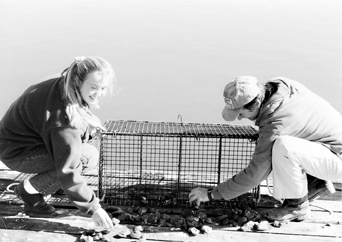
The sites will be monitored but closed to harvest for at least four years to see how CROSBreed oysters grow. Allen’s hope is that he’s bred an oyster that will survive to harvest. He thinks CROSBreed is more likely "to revive the industry through aquaculture than restore a resource or habitat."
"In the short term," he says, "it makes sense to put improved oysters into restoration projects so you get maximum lifespan and reproductive potential. For long-term restoration it may not be tenable, because you can’t make the selected strains breed with each other. They’re going to breed with native oysters and eventually lose their selective advantage."
He’s just one of many arsterin’ for a new century, but he’s one of the hopeful. "I think the strategy that’s evolved makes a lot of sense. Bringing oysters together as a community, concentrating resources on specific areas and giving sanctuary to some of these poor lost souls probably is the most realistic strategy we’ve pursued yet," says Allen.
"Remember how much capacity the Bay has to produce oysters and imagine how big an oyster harvest there could be from the combined resources of both natural oysters and specialized farms."
Volunteer or learn more with the Chesapeake Bay Foundation: 888/save-bay or www.savethebay.cbf.org or the Oyster Recovery Partnership: 410/269-5570.
First Person: My Year with the Oysters
by Carol Glover
Editor’s Note: NBT contributing editor Carol Glover is one of Chesapeake Country’s oyster legions. She volunteered as a citizen scientist in Academy of Natural Sciences’ year-long study of the fate of oysters on the Patuxent River. You’ve read her dispatches over the last year.
Standing on our pier on a bitter cold afternoon early in 1999, we can imagine the Patuxent River of a century ago when oyster bars covered the bottom of the river and skipjacks harvested 15 million bushels a year.
Today -- after a century of overharvesting and natural catastrophe and in company too close with millions of people in a chemical culture -- the only reminder of those glory days on the river is Denton’s Oyster House on Broomes Island. Here oysters trucked from Kent Island, Shady Side and the St. Mary’s River are shucked.
"For the first time in nine years, we’ve shucked oysters from the Patuxent, too," owner Norman Durrell reports. "Divers and tongers were harvesting until Christmas when the water became too murky to work."
Volunteers from CBF’s Citizen Oyster
Corps, left, hoist bags of oyster spat from their floating nursery for replanting
on ‘improved’ oyster reefs.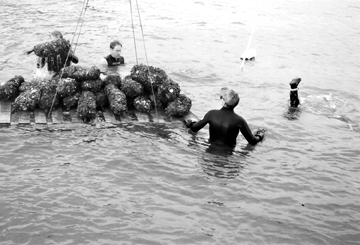
To that good news, my husband Ray and I have added a bit over the last year.
We’ve helped George Abbe and Brian Albright, Academy of Natural Sciences oyster researchers, learn how a devastating disease strikes along the river. Dermo reached our waters from imported West Coast oysters that were thrown into the river and Bay while waiting to be shucked. Now that round, one-celled transparent organism -- smaller than bacteria -- ranges from Florida to Maine and along the Gulf from Florida to Texas. And in most of Chesapeake Bay.
As we haul our oyster tray onto the dock for the last time, we’re sorry our part is ending.
Last January a metal tray holding 100 live Broomes Island oysters was anchored to the side of our pier (NBT Vol. VI No. 8: Feb. 26-March 4, 1998). Through the rainy months of spring, the heat of summer, the cool of fall and harsh December, we faithfully pulled up our oysters to measure their growth, count the survivors and discard the dead.
This scene was repeated on 21 sites on both sides of the river, from the mouth of the Patuxent in Solomons to the Benedict Bridge. All 60 volunteers, the citizen scientists in this oyster research project, have seen it through, although two oyster trays disappeared.
You know people are involved when a neighbor met in the local grocery store leans over the produce section and whispers, "Our oysters grew faster than yours."
Through the winter and spring of 1998, all was well. January through June, the scientists would later learn as they compared all 21 sites, oysters showed very low mortality: under 10 percent throughout the river.
But as summer moved in and water temperature rose, our oysters began to die. Abbe and Albright, studying the effects of salinity and temperature on the growth of dermo, the oyster-killing disease, had warned us that during summer we’d lose oysters.
As the oysters fed on bacteria, they swallowed the dermo cells. A three-inch oyster (legal size for harvest) can contain as many as 100 million dermo cells. The disease spreads from dead oysters: their decomposing flesh releases the disease cells into the water. Neighboring oysters then take in these cells as they feed. Humans aren’t affected.
Abbe compares dermo with the flu: "Oysters can be infected from a light dose, like a person’s having a fever, to a deadly dose, like a person getting pneumonia."
Despite Abbe and Albright’s warnings, we took it personally. First it was just a few. Then, in August, we lost five. At the end of the year, our hundred oysters had dwindled to 83.
Russ Millar, who worked his site at Sotterley Mansion with friend Mike Reese, lamented, "I’ve lost 53 out of 100. That’s a lot of oysters."
From July through September, mortality rose. In salty water near the river’s mouth half of our oysters died. In fresher water mid-river to Benedict, about 10 percent died from October to December, as the water cooled, the rate of death in oysters decreased again to above 10 percent in the lower river to under five percent higher.
The size of harvested oysters, far left,
has shrunk dramtically over the past 100 years.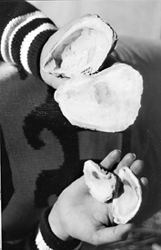
The December days of cooling water brought our experiment to a close. Abbe and Albright gathered in our trays and shucked our remaining oysters. A piece of rectal tissue the size of a fingertip was placed in a sample tube with growth medium and a fungus repellent. After five days at a little higher than room temperature, dermo cells absorb the growth medium and swell. They also stain black and are easy to see.
The number of disease cells went hand in hand with the number of dead oysters. Lots of black dots on the slide reflected lots of deaths, which were highest in Solomons, where water is salty, and lowest near Benedict, where there’s less salt.
After the two researchers gathered their data, they made good on their promise to share our experiment’s results. So many people came to the meeting at the Academy of Natural Sciences that it had to be moved to a larger room and a second night added for people who had to be turned away.
The overflow crowd of scientists, families, Academy of Natural Sciences supporters and citizens spilled through the meeting room and hallways. We citizen-scientists, in reserved seats, sat front and center.
Abbe and Albright hope to add to the base of knowledge we have gathered.
They want to move oysters from one place in the river to another to see
how fast disease-free oysters become infected. They want to see if infected
oysters can recover. There’s always more to learn.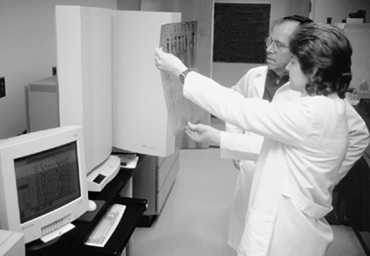
So Ray and I won’t be out of a job, after all. Before we left -- after sharing a cake decorated in honor of the disappearing oyster project -- we’d signed up for the next study, on that old friend Callinectes Sapidus, the Bay’s blue crab.
Become a friend of the Academy of Natural Sciences or learn more: 410/586-9705.
Virginia Marine Institute’s Dr. Standish Allen, at back, works to develop strains of oysters resistant to MSX and dermo.
Feasting on the Harvest
There’s No Better Place to Get to Know Oysters
than a Chesapeake Country Roast
Oyster roasts are feast days up and down the Bay, tributes to the good ol’ days when oysters were harvested in such plenty that roads were paved in their discarded shells. Nowadays we feast as gratefully as the Pilgrims on that first Thanksgiving, knowing full well we could soon go hungry.
Just not this year.
Earleigh Heights Fire Department feasted early in March. American Legion Post #274 feasted last Saturday in Lusby. This Saturday, the feast moves to the Deale Volunteer Fire Department. April 3, it’s the turn of the Davidsonville Ruritan Club. With some 10,000 oysters topping the shopping list, you’ll find one of these as good a place as any to get to know this Chesapeake custom.
On roast Saturday, the hall is stuffed with folk stuffing themselves with oysters. Whatever the weather, it’s shirtsleeve warm inside. In the egalitarian mass, tattooed forearms brush against pink polo shirts. Gnarled watermen, Bayside locals and some of the thousands of weekend sailors stand in the same lines and feast at common tables. Bikers and yuppies get along.
This afternoon of the oyster is dedicated to eating. Anybody not squared off against a heaping plate of raw oysters, steamed oysters, fried oysters or oyster puffs is likely lined up for seconds. The long line for the blue-plate special -- fried oysters with ham, bread, baked beans and salads, sometimes turkey or beef -- moves steadily. Frying is fast when tray upon tray of "patted" oysters -- double-breaded oysters dipped in egg and milk -- wait in neat rows for the hot fat.
But real oyster eaters like ‘em raw best of all. So the line for oysters on the half shell lingers. The shuckers are pros who work at their own pace. These roasts are marathons, not sprints. Endurance counts in a contest waged against hundreds of razor-edged, tight-lipped, mud-slicked bivalves. Fortified by free-flowing beer, the shuckers take each shellfish as a new challenge.
Wedge in the blade, pry open the shell, discard the shallow half. Now carefully -- avoiding chips of shell, globs of mud, the occasional marine worm, spilling as little liquor as possible -- slice the soft gray flesh free from its mother-of-pearl bed. It takes a while to shuck an oyster, certainly longer than it takes to slide the sweet softness down an eager throat.
For today, we feast.
-SOM